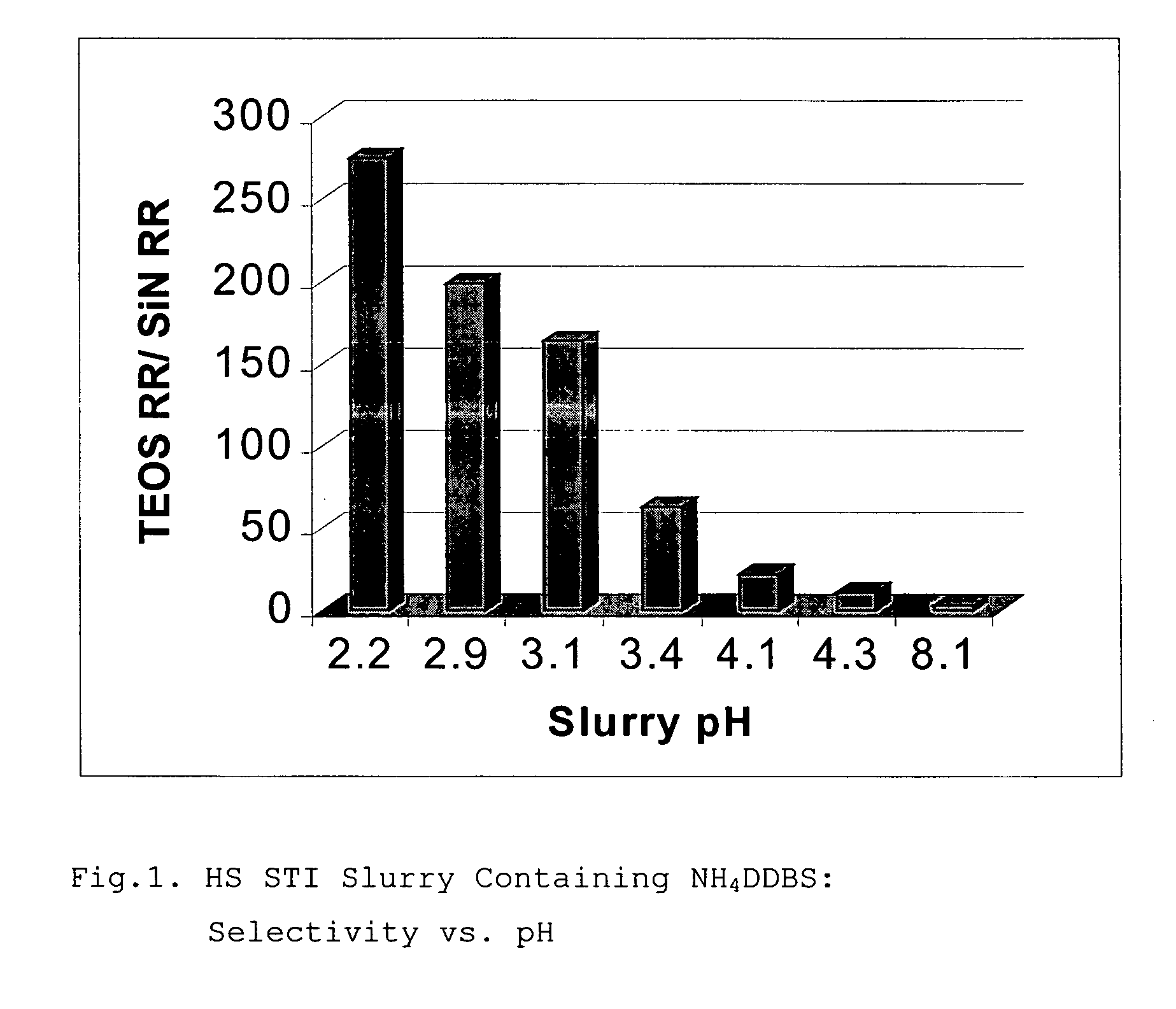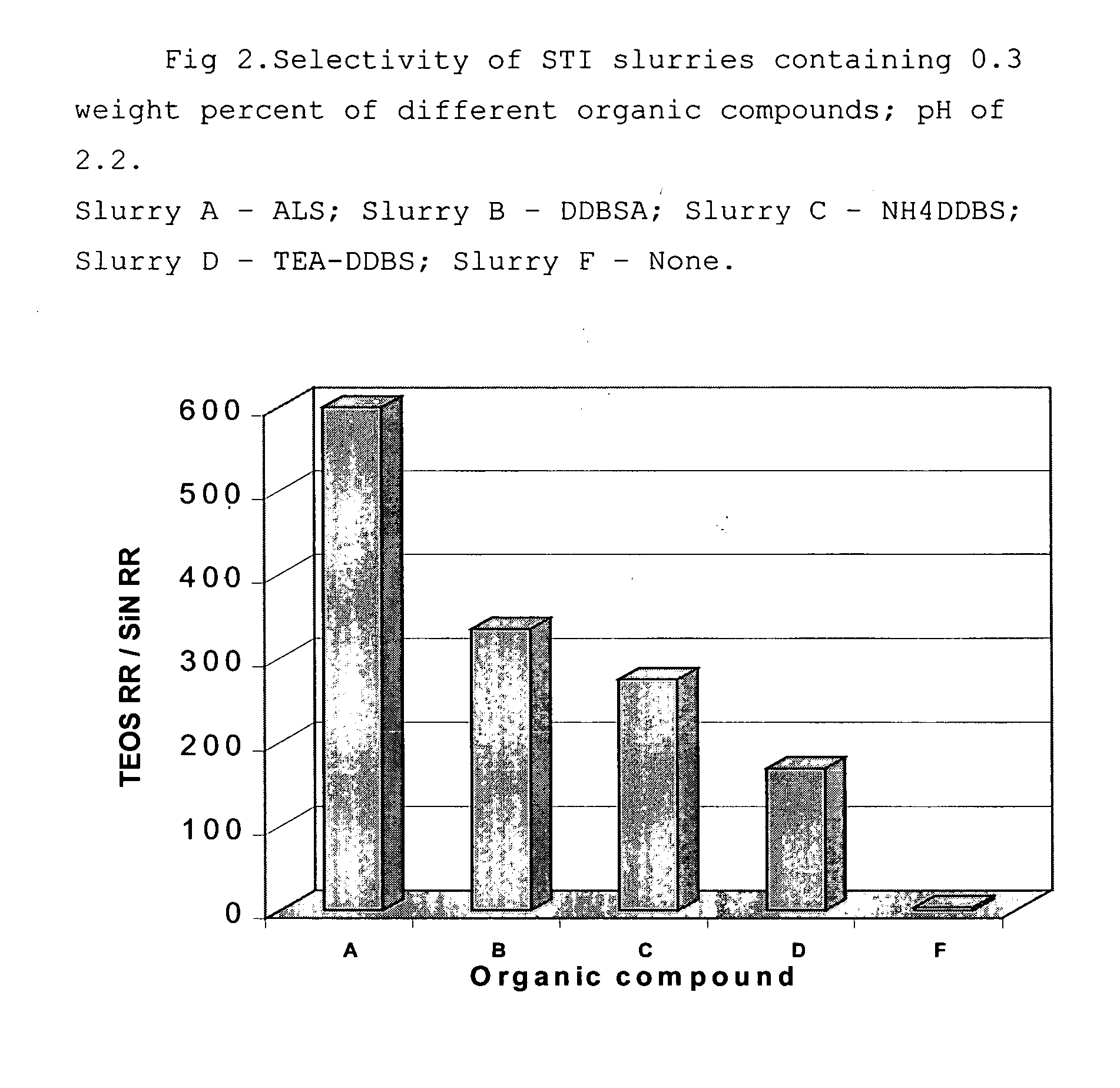High selectivity colloidal silica slurry
a colloidal silica and high selectivity technology, applied in lapping machines, other chemical processes, manufacturing tools, etc., can solve the problems of two-component systems, negative surface planarity, stringent demands, etc., and achieve the effect of minimizing the erosion of silicon nitrid
- Summary
- Abstract
- Description
- Claims
- Application Information
AI Technical Summary
Benefits of technology
Problems solved by technology
Method used
Image
Examples
example 1
[0080] The slurry has been prepared by adding 42 g of ammonium lauryl sulfate (ALS) (as 30 percent ALS aqueous solution, Sigma-Aldrich) to 2.5 liters of commercial non-modified silica colloid (LEVASIL, H. C. Starck, Inc.) with pH of 2.20; silica content in the slurry is 30 weight percent, average particle size was 45 nm. The slurry pH had been equal to 2.45; the amount of ALS in the slurry was equal to 0.4 weight percent.
[0081] As a result, in the above-described polishing test, the removal rate (RR) for silicon oxide film was at 2189 Å / min and the RR for silicon nitride layer was extremely low and equal to 12 Å / min; the oxide:nitride RR selectivity was found to be 186.
examples 2-4
[0082] Slurries of Examples 2-4 were prepared in a similar manner to the slurry of Example 1, except for varying pH and amount of ALS. In the slurry of Example 2, pH was equal to 2.20; pH of the slurries in Examples 3 and 4 has been adjusted by adding 0.5N aqueous solution of KOH. Also, commercial product Stepanol AM-V (Stepan Co.) has been used as a source of ALS (as 28% aqueous solution of ALS).
[0083] Polishing tests on blanket wafers have been performed, as described above and compared to a slurry which does not contain organic compound. The results are tabulated in Table 1, below.
TABLE 1Removal Rate and Selectivity of HS STI Slurries Containing ALSAmount ofALS,RR ofRR ofweightSlurryTEOSSi3N4SelectivitypercentpHÅ / minA / minTEOS / Si3N4Example 10.42.45218912186Example 20.42.1718543600Example 30.42.78226712182Example 40.82.83243117150ComparisonNone2.3524187033.3
[0084] As seen from the data, oxide:nitride selectivity as high as 600 has been achieved with the slurries of the present i...
examples 5-7
[0087] Slurries of Examples 5-6 have been prepared by adding 150 g of ammonium dodecylbenzenesulfonate (NH4DDBS) aqueous solution to 4.0 liters of non-modified colloidal silica dispersion in water so the content of NH4DDBS was 0.31 weight percent. The slurry pH was adjusted to 2.28 and 2.93, for each of the Examples 5 and 6, respectively, by adding NH4OH (as 1M aqueous solution). Silica content in the slurry was 30 weight percent and average particle size was 65 nm.
[0088] Solution of NH4DDBS for the slurries of Example 5 and 6 has been prepared by adding 65 ml of 1M aqueous solution of NH4OH to 220 g of 12.5 weight percent aqueous solution of Dodecylbenzenesulfonic acid (DDBSA). The resulting aqueous solution of NH4DDBS had a pH of 7.82.
[0089] The slurry of Example 7 was prepared by adding 150 g of NH4DDBS aqueous solution and 10 g of ZONYL FSP fluorosurfactant (DuPont Co.,Inc) to 4.0 liters of non-modified colloidal silica dispersion in water; slurry pH was adjusted to a pH of 3....
PUM
| Property | Measurement | Unit |
|---|---|---|
| particle size | aaaaa | aaaaa |
| weight percent | aaaaa | aaaaa |
| particle size | aaaaa | aaaaa |
Abstract
Description
Claims
Application Information
 Login to View More
Login to View More - R&D
- Intellectual Property
- Life Sciences
- Materials
- Tech Scout
- Unparalleled Data Quality
- Higher Quality Content
- 60% Fewer Hallucinations
Browse by: Latest US Patents, China's latest patents, Technical Efficacy Thesaurus, Application Domain, Technology Topic, Popular Technical Reports.
© 2025 PatSnap. All rights reserved.Legal|Privacy policy|Modern Slavery Act Transparency Statement|Sitemap|About US| Contact US: help@patsnap.com


